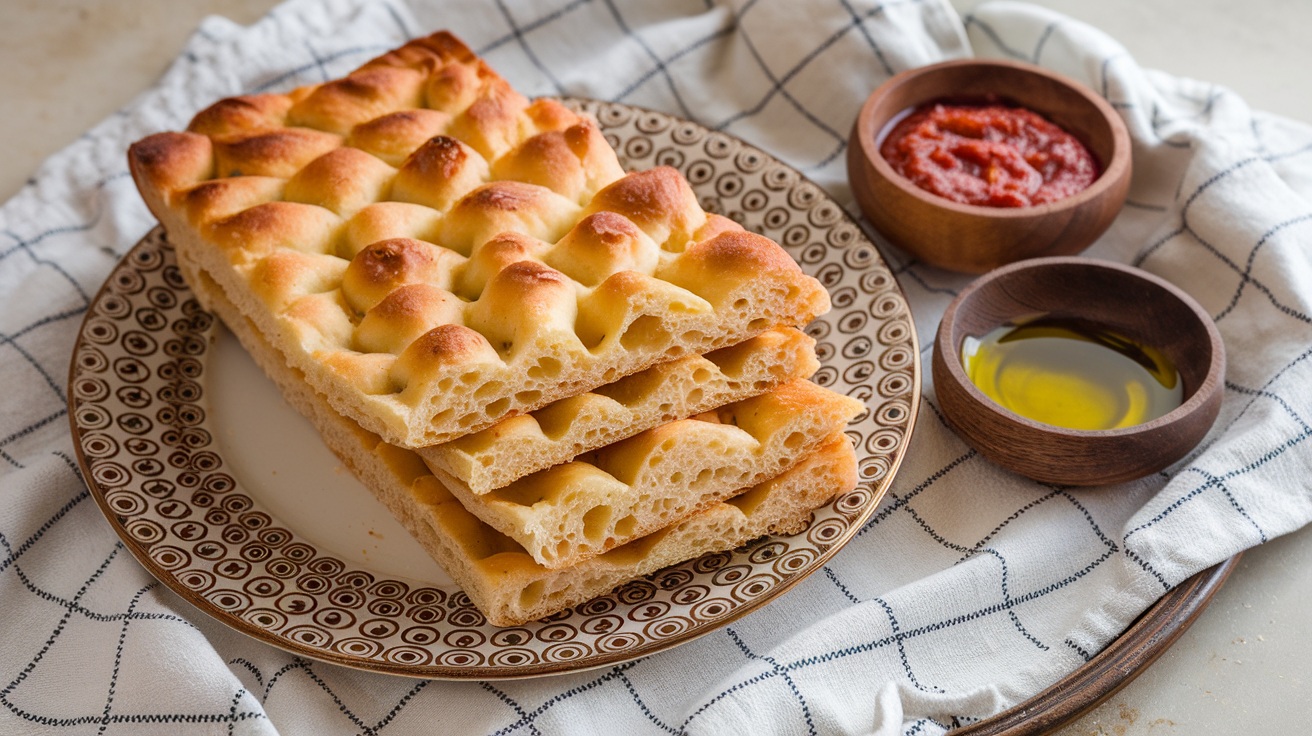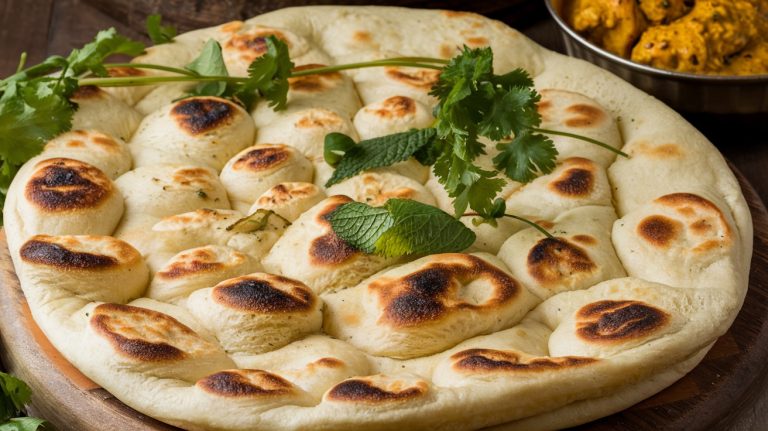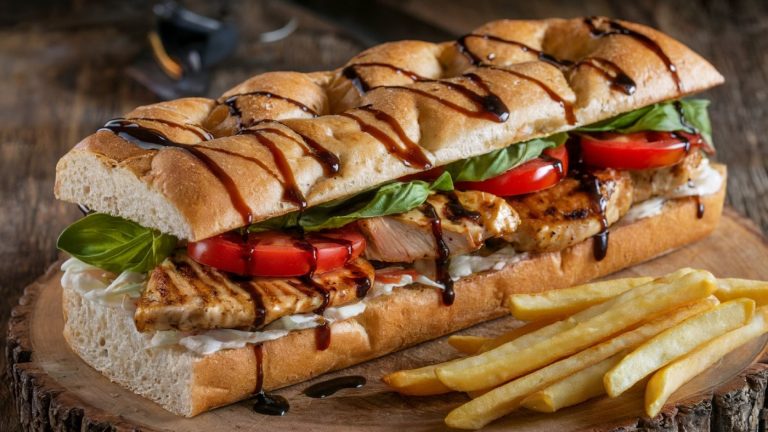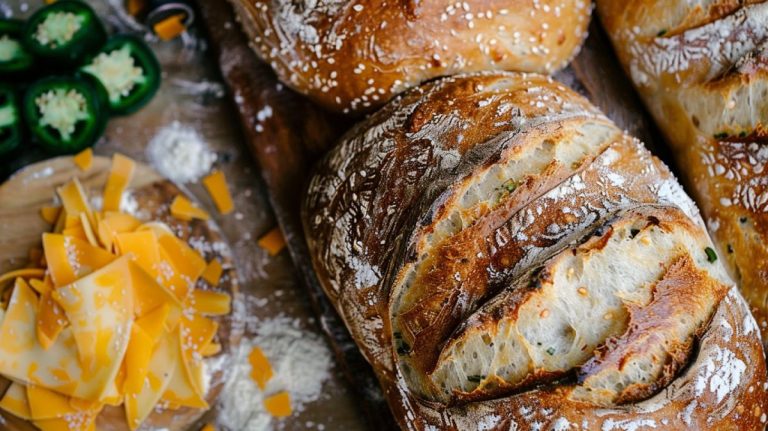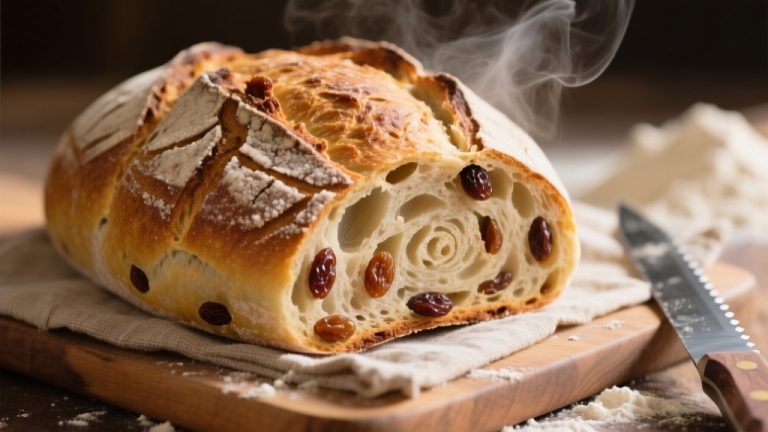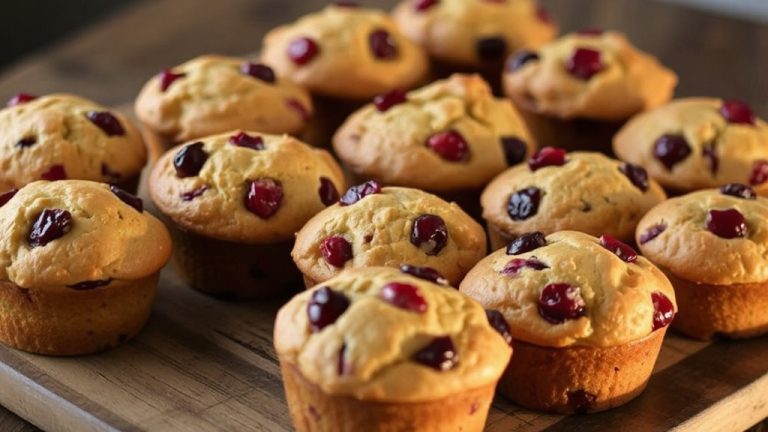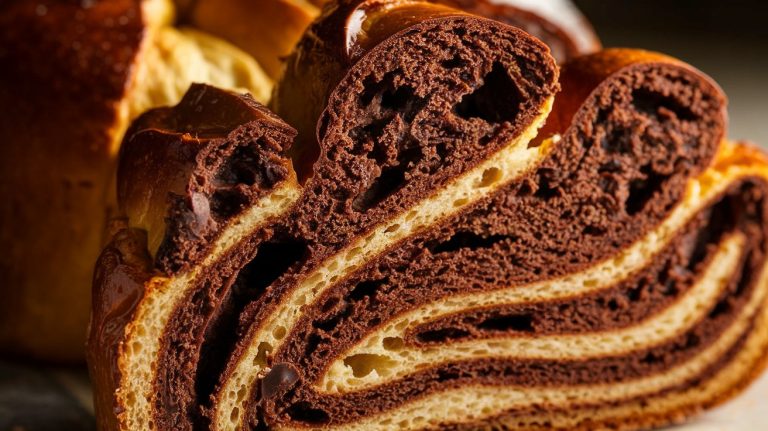Sheet Pan Focaccia: Light, Airy and Simply Irresistible
Sheet-pan focaccia is a delightful, easy-to-make bread that’s perfect for any occasion. Its high hydration level creates a light, airy texture.
You’ll love how the olive oil and rosemary meld into the dough, enriching each bite. The cold fermentation process allows flavors to develop beautifully, while the cast iron skillet enhances the crust’s crunch.
Mix your ingredients, let the dough rise, and then bake until golden brown. You can even customize it with toppings like sun-dried tomatoes or garlic. Keep going to discover tips and tricks for perfecting your focaccia.
Key Takeaways
- Sheet pan focaccia features a high % hydration level of 95% for a light, airy texture and rich flavor from olive oil and rosemary.
- Use a cast iron skillet for enhanced crust texture and better rise during baking at 425°F for about 20 minutes.
- Cold fermentation allows for flavor development, making the dough easier to manage without constant attention.
- Customize your focaccia by adding toppings like olives, sun-dried tomatoes, or fresh herbs for unique flavors.
- Store and freeze focaccia properly to maintain freshness, wrapping tightly and cooling completely before freezing for optimal quality.
Why We Love This Recipe?
When you try this sheet-pan focaccia recipe, you’ll discover why it’s a beloved choice among home bakers. The secret lies in its high hydration level of 95%, which gives the dough a light, airy texture that’s simply irresistible.
As you mix the ingredients, you’ll notice how easily the olive oil and rosemary blend into the dough, infusing it with rich flavor. Baking focaccia in a cast iron skillet enhances the crust’s texture and promotes better rise, making this recipe even more appealing for ideal baking results.
What sets this recipe apart is the cold fermentation process. It allows flavors to develop without requiring constant attention, making your baking experience hassle-free.
You’ll love how the focaccia emerges from the oven with a crispy bottom and a soft, salty top, perfect for pairing with pasta dishes or enjoying on its own.
Another reason this focaccia shines is its versatility. You can easily adapt it to your tastes by adding toppings like olives or sun-dried tomatoes.
Ingredients You Need
Before you plunge into baking your delicious sheet pan focaccia, it’s essential to gather the right ingredients.
You’ll need 5 cups of all-purpose flour, which serves as the foundation of your simple focaccia. A packet of active dry yeast, about 2¼ teaspoons, helps your dough rise beautifully, contributing to the soft texture characteristic of Dutch Oven Focaccia Bread.
Don’t forget 1 tablespoon of sugar to feed that yeast, along with 1 tablespoon + ¾ teaspoon of kosher salt to enhance flavor.
Next, you’ll want 1¾ cups of warm water—make sure it’s not too hot! This helps activate your yeast, creating that airy texture you crave.
The rich flavor and moisture come from ½ cup of extra virgin olive oil, so choose a high-quality one for the best results.
Fresh rosemary is a must for that aromatic touch, but feel free to substitute with sage or thyme if you’re feeling adventurous.
Ingredient Notes and Substitutions
Understanding the essential ingredients for sheet pan focaccia is key to creating a delicious, homemade version of this beloved bread. Start with 5 cups of all-purpose flour, which provides the perfect base; however, using high-quality flour, like natural rattan, can also provide unique benefits for texture and flavor in your baking.
Don’t hesitate to substitute with bread flour for a chewier texture. Instant yeast is your best friend here; it activates quickly without proofing. If you only have active dry yeast, dissolve it in warm water first. You’ll need 1¾ cups of warm water to help the dough rise, along with 1 tablespoon of sugar to feed the yeast.
Kosher salt, at 1 tablespoon plus ¾ teaspoon, enhances the bread’s flavor, ensuring each bite is savory. Olive oil, an essential component, adds richness and helps create that crispy crust you crave; drizzle about ½ cup into the dough and add more on top before baking for extra texture.
Flavor Variations and Substitutions
Why settle for basic focaccia when you can elevate its flavors with a few simple tweaks? Fresh herbs like rosemary offer a classic touch, but why not switch it up? Sage or thyme can create entirely different flavor profiles, bringing a unique twist to your focaccia.
Adding sun-dried tomatoes not only enhances the taste but also provides a rich source of vitamins and antioxidants.
Incorporating toppings is another way to enhance your bread. Think olives, sun-dried tomatoes, or caramelized onions; these additions boost flavor and add delightful texture.
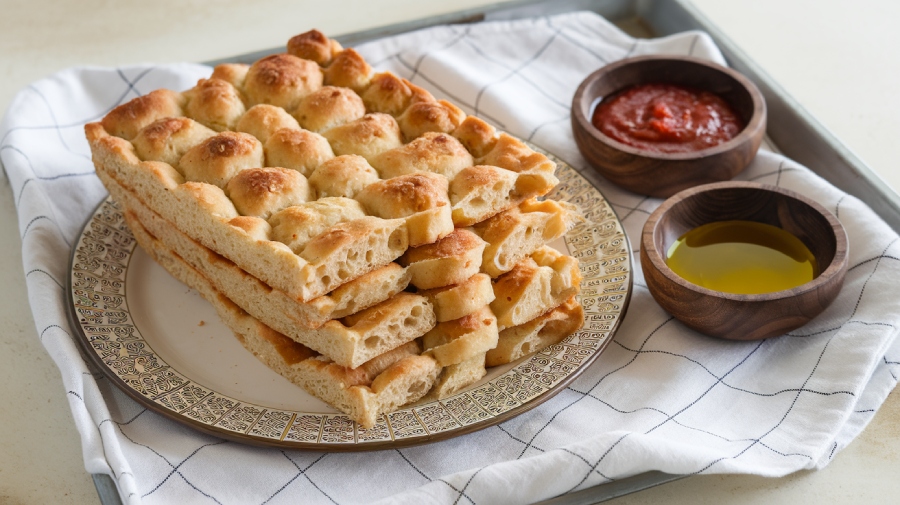
Drizzle garlic-infused olive oil over the dough for a savory punch instead of regular olive oil. This simple substitution can transform your focaccia into a flavor sensation.
Don’t overlook the saltwater brine technique! Applying this before baking amplifies the flavor without making it overly salty.
Try experimenting with different flours, like bread flour or whole wheat, which can greatly alter the bread’s texture, giving it a heartier feel and richer taste.
How to Make This Recipe?
Start by mixing the dough until just combined, then place it in a greased bowl and allow it to rise in a warm environment. This initial rise usually takes about 1 to 2 hours, during which the dough should double in size.
Once it’s risen, gently stretch the dough to fit your greased sheet pan. Make sure to drizzle olive oil over the pan first to prevent sticking.
After placing the dough, create dimples using your fingertips; this not only enhances the texture but also helps with the second rise. Let it sit for about 1 hour until it puffs up nicely.
Before you pop it in the oven, drizzle more olive oil over the surface and sprinkle it generously with flaky sea salt and fresh rosemary for that extra flavor boost.
Baking Process
With the dough prepared and ready, it’s time to focus on the baking process that brings your sheet pan focaccia to life. Start by preheating the oven to 425°F and positioning the rack in the middle for even baking. This temperature will help achieve that perfect golden brown crust you crave.
Next, stretch the dough to fit the baking sheet and create deep dimples using your fingertips. These dimples are vital as they hold the olive oil and toppings, enhancing flavor and texture. Drizzle a generous amount of olive oil over the dough, then sprinkle it with flaky sea salt and fragrant rosemary.
Now it’s time to bake! Place your sheet pan focaccia in the oven and let it bake for about 20 minutes. You’ll know it’s done when the top is beautifully golden brown and the bottom is crisp. To check for doneness, gently lift the edge of the focaccia.
Finally, allow it to cool in the pan for 15 minutes before transferring it to a cutting board. This step is essential for the best texture and flavor, making every bite irresistible.
| Step | Action |
|---|---|
| Preheat the oven | 425°F |
| Stretch the dough | Fit to baking sheet |
| Create dimples | Use fingertips |
| Drizzle olive oil | Generously over the dough |
| Bake | Approximately 20 minutes |
Variations and Customizations
Variations and customizations can elevate your sheet pan focaccia, turning a simple bread into a personalized culinary masterpiece. To begin, consider enhancing your focaccia bread with fresh herbs like rosemary, thyme, or sage. Mixing these into the dough or sprinkling them on top can greatly enrich the aromatic profile.
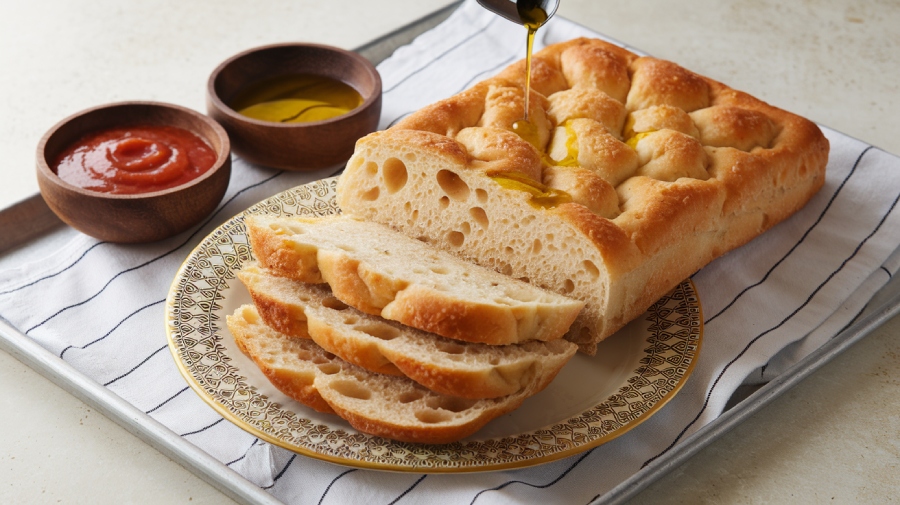
You can also customize the dough by incorporating savory ingredients such as olives, sun-dried tomatoes, or caramelized onions, adding depth to every bite. Toppings are key; experiment with roasted garlic, cheese, or seasonal vegetables to create diverse flavors and striking appearances.
For a delightful twist, try making a tomato focaccia by layering sliced summer tomatoes atop the unbaked dough. As it bakes, their juices will infuse the bread, resulting in a juicy, flavorful treat.
Don’t forget to adjust the quantity of rosemary or other spices to match your taste preferences, ensuring that the balance complements the rich, buttery texture of the focaccia.
Storage Tips
To keep your focaccia fresh, mastering freezing techniques is key.
Wrap it tightly in plastic wrap and foil for maximum preservation, allowing you to enjoy it for up to three months.
When you’re ready to indulge again, simply reheat it in a preheated oven to bring back that delightful texture.
Freezing Techniques
Freezing focaccia is a fantastic way to preserve its delightful flavor and texture for later enjoyment. Start by cooling the focaccia completely to prevent moisture buildup, which can lead to sogginess.
Once it’s cooled, cut it into individual portions; this makes thawing and serving a breeze.
To freeze focaccia effectively, wrap each piece tightly in plastic wrap. This initial layer helps to seal in moisture and freshness.
Next, cover the wrapped focaccia with aluminum foil to protect it from freezer burn. By following this double-wrapping method, you can maintain its quality for up to three months.
For the best results, freeze focaccia when it’s fresh, as this helps preserve its flavor and texture better than freezing leftovers.
Remember to label the wrapped focaccia with the date it was frozen so you can easily keep track of its freshness.
When you’re ready to enjoy your focaccia, place the frozen pieces in a preheated oven at 350°F for 10-15 minutes or until warmed through and crispy.
Frequently Asked Questions
What Kind of Pan Is Best for Focaccia?
When you’re baking focaccia, choose a half-sheet pan for ideal results.
A non-stick pan makes release easy and helps achieve a crispy bottom, while a well-oiled aluminum or stainless steel pan works wonders, too.
Remember, darker pans enhance browning, and thicker ones may need longer baking times.
To elevate crispiness, place your pan on the lowest rack.
With the right choice, your focaccia will rise beautifully and develop that perfect golden crust.
How to Store Focaccia so It Doesn’t Get Soggy?
To keep your focaccia from getting soggy, let it cool completely before storing it.
Place it in an airtight container, but first, wrap it in plastic wrap or aluminum foil. This protects it from air, which can make it stale.
If you want to store it longer, slice it up and freeze the portions tightly in a freezer-safe bag.
When you’re ready to enjoy it, reheat in a preheated oven for a crispy finish.
What’s the Difference Between Focaccia and Panini Bread?
So, you think all bread’s created equal? Think again!
Focaccia is that fluffy, herb-kissed diva with a hydration level that practically sings, while panini bread is the sturdy, no-nonsense companion, built for grilling.
Focaccia’s often drenched in olive oil, flaunting toppings like it’s on a runway, whereas panini bread sticks to its basic roots, focusing on the fillings.
Each serves its purpose, but one’s a party starter while the other’s the reliable sidekick.
Is It Better to Use Bread Flour or All-Purpose Flour for Focaccia?
When making focaccia, bread flour, due to its higher protein content, can give you a chewier, more structured bread.
If you prefer a softer texture, all-purpose flour is a great choice.
Remember that hydration levels matter; bread flour might need a bit more water.
You can also experiment with a blend of both for a flavor and texturally satisfying focaccia.
A Celebration in Every Bite
In the end, your sheet pan focaccia will rise like a beautiful sunset, golden and inviting. The aroma will dance through your kitchen, beckoning family and friends to gather around the table.
You’ve crafted a masterpiece, a canvas for toppings that reflect your taste and creativity. So, embrace the joy of sharing this warm delight, because every bite is a celebration, a moment that lingers like a sweet melody long after the last crumb is gone.

